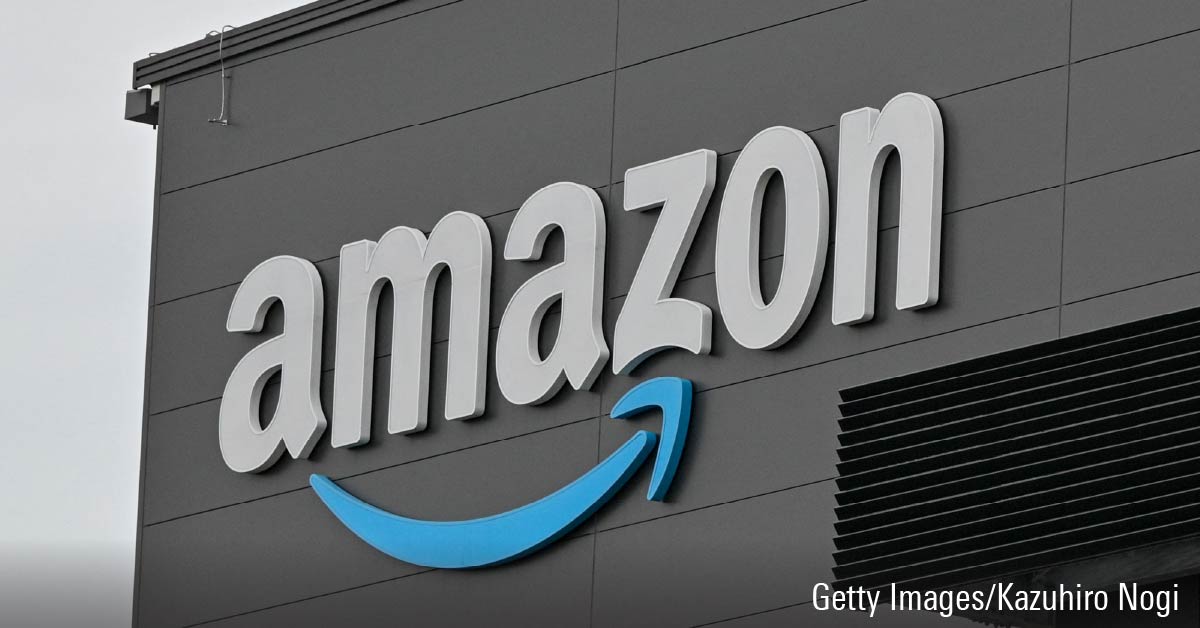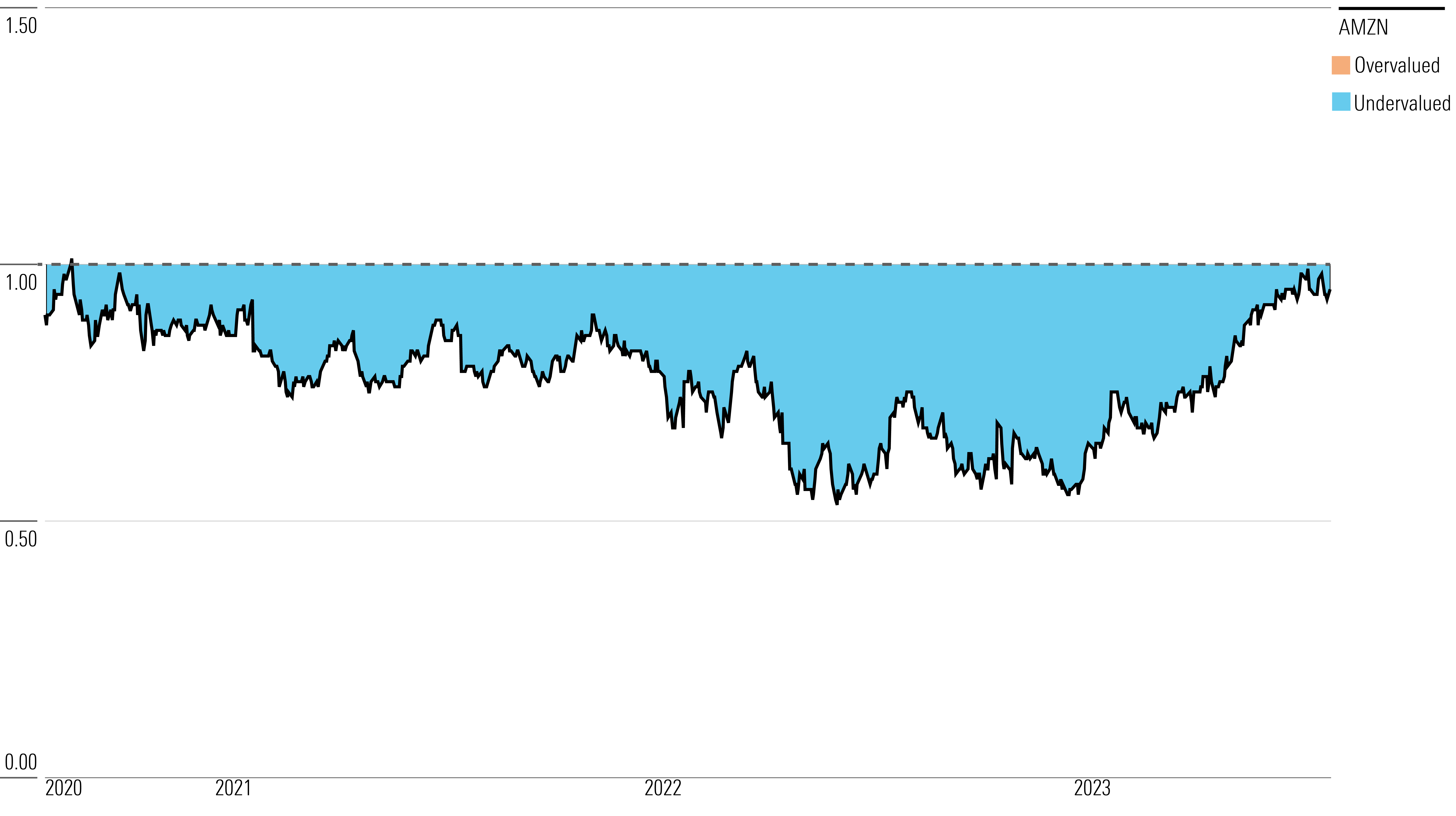After Earnings, Is Amazon Stock a Buy, a Sell, or Fairly Valued?
With shortened delivery times and growth in AWS and digital advertising, here’s what we think of Amazon stock.

Amazon.com AMZN released its second-quarter earnings report on Aug. 3 after the close of trading. Here’s Morningstar’s take on Amazon’s earnings and stock.
Key Morningstar Metrics for Amazon
- Fair Value Estimate: $150
- Morningstar Rating: 3 stars
- Morningstar Economic Moat Rating: Wide
- Morningstar Uncertainty Rating: High
What We Thought of Amazon’s Q2 Earnings
Amazon shares just had a massive run, so we removed it from our “Best Ideas” list. But we recommend that current owners hold onto the stock, as trends are moving in the right direction—results over the next several quarters and related estimates will likely be biased toward the upside.
From a long-term perspective, Amazon still dominates e-commerce and public cloud (both secular themes), and its advertising business is clearly outperforming that of its peers. There is also optionality from artificial intelligence that investors are not appreciating. It’s a franchise name that seems to be getting its mojo back.
- Increase in fair value estimate: We are raising our fair value estimate for Amazon from $137 to $150. Overall results were strong, with upside to the top and bottom lines and better-than-consensus guidance. We didn’t want to get overly aggressive in changing our estimates beyond near-term guidance; we prefer to wait to see how some of these trends continue into the next quarter, and we already assume acceleration through next year for most segments.
- Strong overall results: The second quarter was good for Amazon from almost any angle. Amazon Web Services has stabilized, margins continue to strengthen, e-commerce demand is improving, and advertising is clearly taking a share of digital ad dollars.
- Healthy AWS growth: AWS grew 12% year over year in constant currency as contract optimization began to ease and new workloads (particularly related to AI) were brought online. Growth was 33% a year ago and 16% last quarter. Microsoft is seeing similar patterns. We already model an acceleration to 18% next year, so our fair value estimate for Amazon hinges a bit on that trajectory. We expect AWS to be a leader in AI over the next five years.
- Shortened delivery times: Operating margins improved by 3 percentage points year over year to 5.7% as the company continued to focus on its regional hubs and speeding up delivery. They now have eight hubs instead of one national model. This has helped shorten miles traveled and improve inventory management. It’s impressive that margins can improve this much while Amazon is doing those things and continuing to invest. Third-quarter guidance calls for 5.0% margins at the midpoint.
- Demand resurgence: E-commerce or retail (including first-party, third-party, physical stores, and subscriptions) grew 9% from year-ago levels. It’s nice to see demand coming back.
- Digital advertising growth: Advertising grew 22% year over year, representing an acceleration both year over year and sequentially. While these ads are not the same as the experience Facebook or Google offer, we’d simply point out that Amazon is quite clearly taking digital advertising share.
Amazon Stock Price
Fair Value Estimate for Amazon
With its 3-star rating, we believe Amazon’s stock is fairly valued compared with our long-term fair value estimate.
Our fair value estimate for Amazon is $150 per share, which implies a 2022 enterprise value to sales multiple of 3 times and a 2.5% free cash flow yield. We think multiples are a little less meaningful for Amazon, given the ongoing heavy investment and rapid scaling that depresses financial performance. However, we expect the company to significantly grow its free cash flow as it matures.
Over the long term, we expect e-commerce to continue to take share from brick-and-mortar retailers. We further expect Amazon to gain share online. We believe that over the medium term, the COVID-19 pandemic pulled forward some demand by changing consumer behavior and better penetrating some retail categories that had not previously gained as much traction online, such as groceries, pharmacies, and luxury goods. We think Prime subscriptions and the accompanying benefits, combined with selection, price, and convenience, continue to drive the retail story. We also see international as a longer-term opportunity within retail. We model total retail-related revenue growing at an 8% compound annual growth rate over the next five years.
Read more about Amazon’s fair value estimate.
Amazon Price/Fair Value

Economic Moat Rating
We assign Amazon a wide moat based on its network effects, cost advantages, intangible assets, and switching costs.
Amazon has been disrupting the traditional retail industry for more than two decades while also emerging as the leading infrastructure-as-a-service provider via AWS. This disruption has been embraced by consumers and driven change across the entire industry, as traditional retailers have invested heavily in technology to keep pace. COVID-19 has accelerated this change. Given the company’s technological prowess, massive scale, and relationship with consumers, we think Amazon has widened its lead. We believe this will result in economic returns well in excess of the firm’s cost of capital for years to come.
We believe Amazon’s retail business has network effects associated with its marketplace, whereby the great number of buyers and sellers continually attract even more buyers and sellers. It also has a cost advantage tied to its purchasing power, logistics, vertical integration (proprietary brands, owned delivery, and so on), and a negative cash conversion cycle. Finally, it has intangible assets associated with technology and branding.
Additionally, we believe AWS is a wide-moat business thanks to high customer switching costs, a cost advantage associated with economies of scale (few competitors can keep up with Amazon’s investment pace), intangible assets arising from semiconductor and facility development, and a network effect associated with a marketplace for software created to make AWS work better.
We would also assign Amazon’s burgeoning advertising business a narrow moat based on intangible assets from its proprietary data on hundreds of millions of users, as well as a network effect focused on buyers and sellers meeting in the largest available venues.
We believe the wide moat for Amazon’s entire business is greater than the sum of its parts. We prefer to analyze the company’s moat on the whole, as its segments reinforce one another and their returns result in an unrivaled consumer experience. We see little difficulty for Amazon to continue delivering returns on invested capital well in excess of its cost of capital over the long term.
Read more about insert Amazon’s moat rating.
Risk and Uncertainty
We believe the uncertainty around Amazon is high, and that despite being an e-commerce leader, the company faces a variety of risks.
Amazon must protect its leading online retail position, which can be challenging, as traditional retailers bolster their online presences and consumer preferences change, especially amid the return to normalcy after the peak of the COVID-19 pandemic (as they may revert to prior behaviors). The company has made investments in nontraditional areas to maintain its e-commerce edge, such as producing original content for Prime Video and building out its own transportation network.
Similarly, the company must maintain an attractive value proposition for its third-party sellers. Some of these investment areas have raised investor questions in the past, and we expect management to continue to invest according to its strategy, despite periodic margin pressure from increased spending.
Continued international expansion will likely require similar investment and management attention, but will also increase exposure to different regulatory environments. Some countries have instituted or may institute protectionist policies. Even in the United States over the last several years, lawmakers from both major political parties have increasingly focused on the amount of market power large technology companies have accrued. Antitrust, data privacy, and Section 230 have repeatedly been invoked.
From an environmental, social, and governance perspective, data breaches and service outages are a concern for any type of cloud service provider. As a retailer, Amazon has the personal information of hundreds of millions of consumers around the world, while AWS hosts proprietary mission-critical data for enterprises.
Read more about Amazon’s risk and uncertainty.
AMZN Bulls Say
- Amazon is the clear leader in e-commerce, and it enjoys an unrivaled scale to continue to invest in growth opportunities and drive the very best customer experience.
- High-margin advertising and AWS are growing faster than the corporate average, which should continue to boost profitability over the next several years.
- Amazon Prime memberships help attract and retain customers who spend more with Amazon; this reinforces a powerful network effect while bringing in recurring and high-margin revenue.
AMZN Bears Say
- Regulatory concerns are rising for large technology firms, including Amazon. The firm may also face increasing regulatory and compliance issues as it expands internationally.
- New investments—notably in fulfillment, delivery, and AWS—should dampen free cash flow growth. Additionally, Amazon’s penetration into some countries might be harder than in the U.S. due to inferior logistics.
- Amazon may not be as successful at penetrating new retail categories such as luxury goods due to consumer preferences and an improved e-commerce experience from larger retailers.
This article was compiled by Saaketh Tirumala.
The author or authors do not own shares in any securities mentioned in this article. Find out about Morningstar’s editorial policies.


/cloudfront-us-east-1.images.arcpublishing.com/morningstar/6ZMXY4RCRNEADPDWYQVTTWALWM.jpg)
/d10o6nnig0wrdw.cloudfront.net/05-20-2024/t_dc0763464c0a4191b876af1624b96f43_name_file_960x540_1600_v4_.jpg)
/cloudfront-us-east-1.images.arcpublishing.com/morningstar/IPKX4IWSDBD3VJC2Y34W6STFL4.jpg)